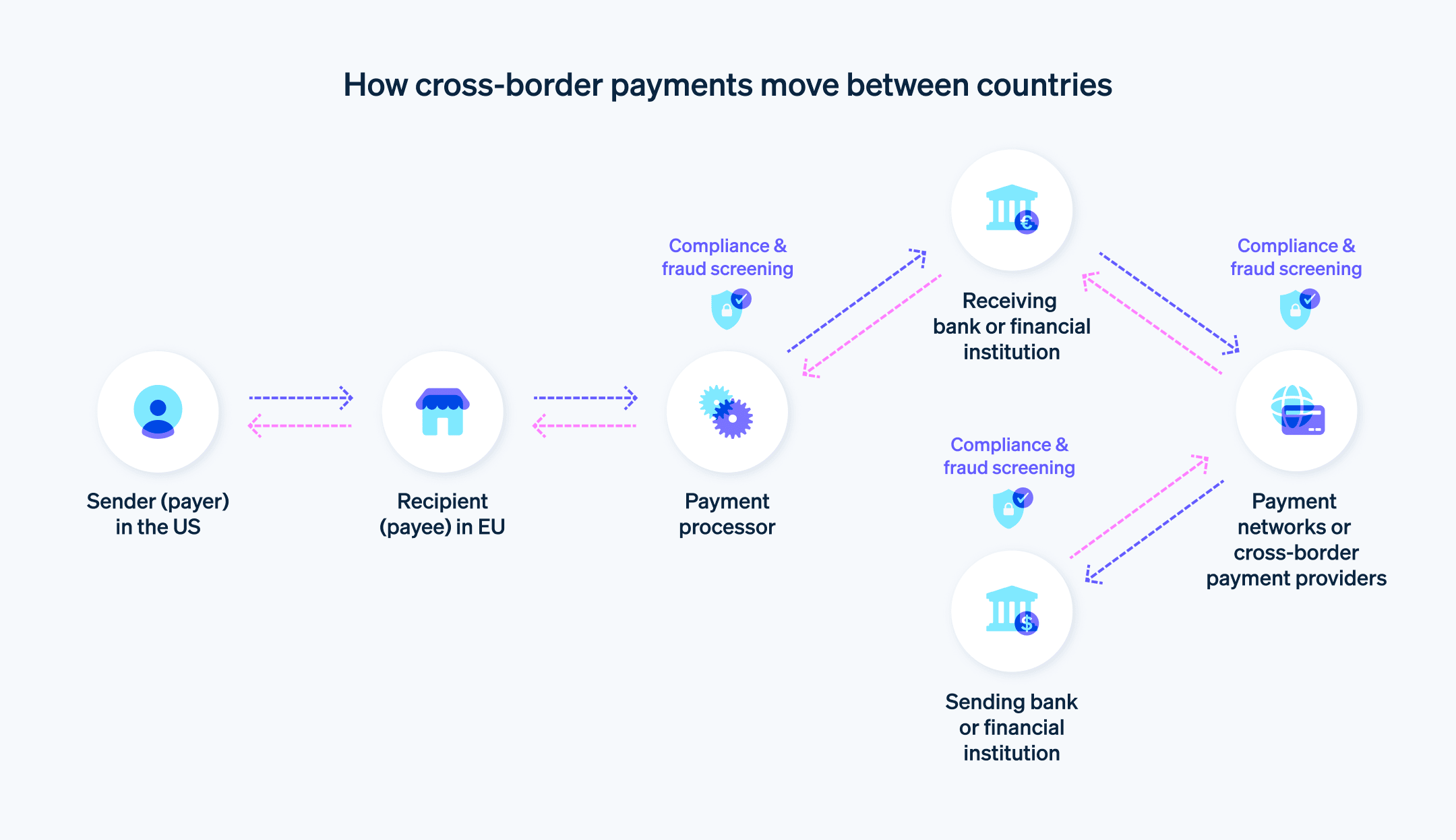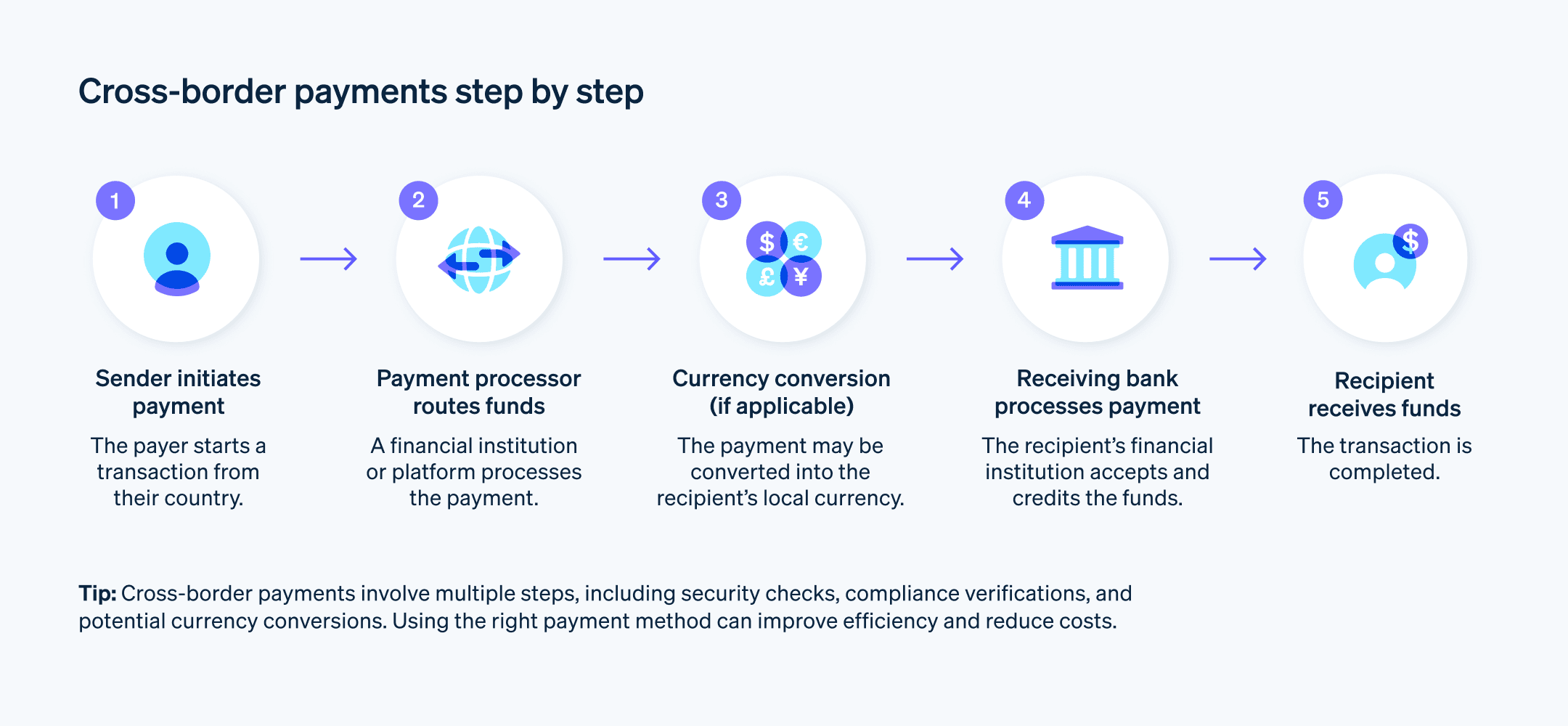À medida que o marketplace global continua a se expandir, mais empresas estão aproveitando as oportunidades de comércio internacional. Em 2022, os clientes pagaram às empresas cerca de US$ 2,8 trilhões em pagamentos internacionais, enquanto mais de US$ 150 trilhões em pagamentos internacionais B2B ocorreram no mesmo ano. No entanto, enviar e receber pagamentos internacionais pode ser um processo complexo e desafiador, com vários requisitos regulatórios, tarifas e riscos a serem enfrentados.
Apesar desses desafios, os pagamentos internacionais são importantes para empresas que desejam expandir para novos mercados, alcançar novos clientes e diversificar fluxos de receita. E há soluções para esses desafios. Com as formas de pagamento e estratégias adequadas, as empresas podem reduzir custos, melhorar o fluxo de caixa e acelerar o crescimento.
A seguir, exploramos os diversos tipos de pagamentos internacionais disponíveis, as vantagens e desvantagens para as empresas, bem como o processo de envio e recebimento de pagamentos internacionais. Se você tem uma empresa estabelecida ou uma startup em crescimento, é importante entender e planejar a administração de pagamentos internacionais para se manter competitivo e manter suas operações financeiras o mais eficiente e eficaz possível.
O que há neste artigo?
- O que são pagamentos internacionais?
- Formas de pagamento internacionais
- Para que servem os pagamentos internacionais?
- Vantagens e desvantagens dos pagamentos internacionais
- Como enviar pagamentos internacionais
- Pagamentos internacionais com a Stripe
O que são pagamentos internacionais?
Pagamentos internacionais são transações financeiras realizadas entre partes localizadas em países diferentes. Esses pagamentos envolvem a transferência de fundos ou ativos de um país para outro, normalmente por meio de bancos ou outras instituições financeiras. Essas transações podem ser iniciadas por pessoas físicas ou jurídicas, geralmente envolvem conversões de moedas e podem ser feitas usando diversas formas de pagamento.
Formas de pagamento internacionais
Um pagamento é considerado um internacional quando o pagador e o beneficiário estão localizados em países diferentes, independentemente do mecanismo pelo qual o pagamento ocorre. Para qualquer transação, a escolha ideal da forma de pagamento depende de vários fatores, como a quantidade de dinheiro que está sendo transferido, a velocidade da transação, as moedas envolvidas e as tarifas associadas a cada método. As empresas e pessoas físicas que precisam iniciar um pagamento internacional devem ter em conta as diferentes formas de pagamento disponíveis e escolher a opção mais adequada às suas necessidades específicas.
Existem várias formas comuns de pagamentos internacionais, incluindo:
Wire transfers: uma wire transfer é uma transferência eletrônica de fundos entre dois bancos ou instituições financeiras diferentes. Em diferentes partes do mundo, as wire transfers são transmitidas usando várias redes que atendem a diferentes áreas geográficas. Esse tipo de pagamento geralmente é usado para grandes transações (os limites de valor variam conforme o local e a rede) e pode ser enviado em diferentes moedas.
Transações com cartão de crédito: os cartões de crédito são amplamente aceitos em todo o mundo, e as empresas podem aceitar pagamentos de clientes em diferentes moedas. As transações com cartão de crédito podem estar sujeitas a tarifas de conversão de moeda e outros encargos.
Transferências eletrônicas de fundos (EFTs): as transferências eletrônicas de fundos são comumente chamadas de transferências bancárias eletrônicas, cheques eletrônicos ou pagamentos eletrônicos. Essas transferências permitem que pessoas físicas e empresas enviem e recebam dinheiro eletronicamente de forma rápida e segura. Esse tipo de pagamento é normalmente mais rápido e conveniente do que outras formas de pagamentos internacionais.
Ordens de pagamento internacionais: as ordens de pagamento internacionais são uma forma de pagamento em papel que pode ser enviada pelo correio ou transmitida eletronicamente por um provedor externo. Elas podem ser compradas em bancos e outras instituições financeiras e normalmente são usadas para valores de transação menores.
Plataformas de pagamentos online: as plataformas de pagamentos online permitem que pessoas físicas e empresas enviem e recebam dinheiro internacionalmente usando dispositivos móveis ou computadores. Essas plataformas geralmente oferecem taxas de câmbio competitivas e tarifas baixas. Muitas redes de cartão de crédito também oferecem pagamentos internacionais online.
Criptomoedas: criptomoedas como Bitcoin e Ethereum são moedas digitais descentralizadas que podem ser usadas para fazer pagamentos internacionais. Um estudo mostrou que 75% dos varejistas planejam aceitar criptomoedas como forma de pagamento até 2024. Esses pagamentos podem ser processados de forma rápida e segura, mas as criptomoedas apresentam algumas desvantagens devido à volatilidade no mercado de criptomoedas.

Para que são usados os pagamentos internacionais?
Os pagamentos internacionais são um componente importante da economia global, permitindo o fluxo de dinheiro entre países para uma ampla gama de finalidades. Tanto em contextos profissionais como pessoais, os pagamentos internacionais são utilizados para diversas finalidades, incluindo:
Comércio internacional
Os pagamentos internacionais são importantes para empresas que importam ou exportam bens e serviços entre países diferentes. Eles permitem que as empresas paguem por bens e serviços de fornecedores e recebam pagamentos de clientes em outros países.Viagens e turismo
Os pagamentos internacionais permitem que os viajantes comprem e paguem por serviços como voos, hotéis e passeios quando viajam internacionalmente.Remessas
Os pagamentos internacionais permitem que pessoas físicas enviem dinheiro para familiares e amigos que vivem em outros países, o que é importante para apoiar famílias e comunidades em países em desenvolvimento.Investimento
Os pagamentos internacionais permitem que os investidores comprem ativos como ações, títulos e imóveis em outros países e recebam rendimentos e lucros desses investimentos.Doações internacionais de caridade
Os pagamentos internacionais permitem que indivíduos e organizações façam doações para instituições de caridade e organizações sem fins lucrativos que operam em outros países, apoiando uma grande variedade de causas e iniciativas em todo o mundo.
Vantagens e desvantagens dos pagamentos internacionais
Os pagamentos internacionais podem criar oportunidades significativas para que as empresas se expandam para novos mercados e aumentem a receita, tudo isso com mais facilidade, eficiência e rapidez. No entanto, eles também vêm com vários riscos e desafios que devem ser cuidadosamente gerenciados para evitar problemas.
Aqui estão algumas das principais vantagens e desvantagens:
Vantagens
- Acesso aos mercados globais: os pagamentos internacionais permitem que as empresas se expandam para mercados globais e alcancem novos clientes, fornecedores e parceiros.
- Aumento de receitas e oportunidades de crescimento: ao vender bens e serviços internacionalmente, as empresas podem aumentar suas receitas e aproveitar novas oportunidades de crescimento.
- Diversificação: os pagamentos internacionais permitem que as empresas diversifiquem sua base de clientes, base de fornecedores e carteira de investimentos, reduzindo a dependência dos mercados nacionais.
- Redução de custos: algumas formas de pagamento internacionais podem ser mais econômicas do que outras, permitindo que as empresas economizem em tarifas de transação, taxas de câmbio e outros custos associados ao comércio internacional.
- Flexibilidade: os pagamentos internacionais oferecem flexibilidade às empresas em termos de formas de pagamento, permitindo que elas escolher a opção mais conveniente e econômica para suas necessidades específicas.
Desvantagens
- Requisitos regulamentares: os pagamentos internacionais estão sujeitos a vários requisitos regulatórios e obrigações de conformidade, que podem ser complexos e demorados.
- Risco cambial: os pagamentos internacionais estão sujeitos a flutuações nas taxas de câmbio, que podem impactar o valor das transações e afetar o fluxo de caixa das empresas.
- Tarifas e encargos: algumas formas de pagamento internacionais podem ser caras, com as tarifas e cobranças variando conforme o país e a forma de pagamento.
- Riscos de fraude e segurança: os pagamentos internacionais podem estar vulneráveis a fraudes e riscos de segurança, como ataques cibernéticos, roubo de identidade e golpes de pagamento.
- Complexidade operacional: o processamento de pagamentos internacionais pode ser mais complexo e demorado do que os pagamentos nacionais, exigindo que as empresas disponham dos recursos e conhecimentos necessários para os gerir de forma eficaz.
Como enviar pagamentos internacionais
O envio de pagamentos internacionais requer planejamento cuidadoso e atenção aos detalhes. O processo é executado mais facilmente com um provedor de pagamentos que esteja familiarizado com sua empresa, suas contas financeiras e as partes internacionais com as quais você faz transações com frequência. Escolha a forma de pagamento correta para suas necessidades e verifique cuidadosamente todos os detalhes para garantir que o pagamento seja processado com rapidez, precisão e segurança.
O processo de enviar pagamentos internacionais pode variar, dependendo do destino e origem dos fundos e do método de transferência escolhido, mas estas são as etapas básicas:
1. Escolha uma forma de pagamento
Há várias maneiras de enviar pagamentos internacionais, incluindo wire transfers, transações por cartão de crédito, transferências eletrônicas de fundos, ordens de pagamento internacionais, plataformas de pagamentos online e criptomoedas. Cada método tem suas próprias vantagens e desvantagens, portanto, escolha o que melhor se adapta às suas necessidades.
2. Verifique a taxa de câmbio
Se você estiver enviando um pagamento internacional em uma moeda diferente, será preciso verificar a taxa de câmbio para garantir que você entenda o custo da transferência e qual será o valor recebido na outra ponta. As taxas de câmbio podem variar, dependendo do país e da forma de pagamento.
3. Forneça os dados do beneficiário
Para enviar um pagamento internacional, você precisa informar os dados do beneficiário, incluindo nome, endereço, número da conta bancária e routing number. Também pode ser necessário fornecer informações adicionais, como o motivo do pagamento e os números de referência relevantes. Diferentes instituições financeiras e redes de transferência podem exigir informações diferentes para processar a transferência.
4. Verifique o pagamento
Antes de enviar um pagamento internacional, verifique todos os detalhes para garantir que estejam corretos. Isso ajuda a evitar atrasos ou erros no processo de pagamento, o que é especialmente importante para formas de pagamento irreversíveis, como ordens de pagamento.
5. Envie o pagamento
Depois de verificar o pagamento, você poderá enviá-lo usando a forma de pagamento escolhida. O tempo de recebimento do pagamento pode variar de acordo com o método utilizado e os países envolvidos.
6. Acompanhe o pagamento
É recomendável monitorar seu pagamento internacional para garantir que seja recebido pelo destinatário. Isso pode ser feito usando o número de rastreamento ou número de referência fornecido pelo seu provedor de pagamento.

Pagamentos internacionais com a Stripe
A Stripe foi feita para simplificar o processo de aceitação de pagamentos de clientes em diferentes países. Usando a plataforma da Stripe, as empresas podem gerenciar várias moedas, formas de pagamento e requisitos de conformidade a partir de uma única integração. O serviço da Stripe também pode ajudar a reduzir custos e melhorar a rapidez e a eficiência dos pagamentos internacionais.
A Stripe processa pagamentos de 197 países, e o Stripe Radar usa machine learning para detectar e bloquear transações fraudulentas de todo o mundo antes que sejam processadas. Ferramentas avançadas de detecção de fraudes, como o Radar, permitem vender para clientes de qualquer lugar sem se preocupar com a introdução de novos riscos de fraudes em transações internacionais.
Com a ajuda do provedor de pagamentos certo, os pagamentos internacionais permitem que as empresas cresçam em escala global sem complicar demais os processos de pagamento. Confira uma lista completa das moedas aceitas pela Stripe.
O conteúdo deste artigo é apenas para fins gerais de informação e educação e não deve ser interpretado como aconselhamento jurídico ou tributário. A Stripe não garante a exatidão, integridade, adequação ou atualidade das informações contidas no artigo. Você deve procurar a ajuda de um advogado competente ou contador licenciado para atuar em sua jurisdição para aconselhamento sobre sua situação particular.